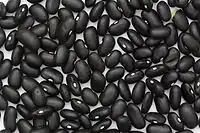Black turtle bean
The black turtle bean is a small, shiny variety of the common bean (Phaseolus vulgaris) especially popular in Latin American cuisine, though it can also be found in the Cajun and Creole cuisines of south Louisiana. Like all varieties of the common bean, it is native to the Americas,[2] but has been introduced around the world. It is also used in Indian cuisine, Tamil cuisine, where it is known as karuppu kaaramani and in Maharashtrian cuisine, where it is known as Kala Ghevada. The black turtle bean is often simply called the black bean (frijoles negros, zaragoza, judía negra, poroto negro, caraota negra, or habichuela negra in Spanish; and feijão preto in Portuguese), although this terminology can cause confusion with other black beans.
 | |
| Nutritional value per 100 g (3.5 oz) | |
|---|---|
| Energy | 552 kJ (132 kcal) |
23.71 | |
| Sugars | 0.32 |
| Dietary fiber | 8.7 |
0.54 | |
| Saturated | 0.139 |
| Trans | 0 |
| Monounsaturated | 0.047 |
| Polyunsaturated | 0.231 |
8.86 | |
| Vitamins | Quantity %DV† |
| Vitamin A equiv. | 0% 0 μg |
| Vitamin A | 6 IU |
| Thiamine (B1) | 21% 0.244 mg |
| Riboflavin (B2) | 5% 0.059 mg |
| Niacin (B3) | 3% 0.505 mg |
| Vitamin B6 | 5% 0.069 mg |
| Folate (B9) | 37% 149 μg |
| Vitamin B12 | 0% 0 μg |
| Vitamin C | 0% 0 mg |
| Vitamin D | 0% 0 μg |
| Vitamin E | 6% 0.87 mg |
| Vitamin K | 3% 3.3 μg |
| Minerals | Quantity %DV† |
| Calcium | 3% 27 mg |
| Iron | 16% 2.10 mg |
| Magnesium | 20% 70 mg |
| Phosphorus | 20% 140 mg |
| Potassium | 8% 355 mg |
| Sodium | 16% 237 mg |
| Zinc | 12% 1.12 mg |
| Other constituents | Quantity |
| Water | 65.74 g |
| |
| †Percentages are roughly approximated using US recommendations for adults. Source: USDA FoodData Central | |
Background
The black bean has a dense, meaty texture, which makes it popular in vegetarian dishes, such as frijoles negros and the Mexican-American black bean burrito. It is a very popular bean in various regions of Brazil, and is used in the national dish, feijoada. It is also a main ingredient of Moros y Cristianos in Cuba, is a required ingredient in the typical gallo pinto of Costa Rica and Nicaragua, is a fundamental part of Pabellón criollo in Venezuela, and is served in almost all of Latin America, as well as many Hispanic enclaves in the United States. In the Dominican Republic cuisine, it is also used for a variation of the Moros y Cristianos simply called Moro de habichuelas negras. The black turtle bean is also popular as a soup ingredient. In Cuba, black bean soup is a traditional dish, usually served with white rice.
The bean was first widely grown in the present-day United States after the Mexican–American War (1846–1848), however, initially the variety was primarily grown as a snap pea (for the edible seed pod).[3]
It is also common to keep the boiled water of these beans (which acquires a black coloring) and consume it as a soup with other ingredients for seasoning (known as sopa negra, black soup, or as ‘‘sopa de frijoles’’, bean soup), as a broth (caldo de frijol, bean broth) or to season or color other dishes (aforementioned gallo pinto, for example).
Samples of black turtle beans were reported in 2006 to contain total anthocyanins in their dried seed coats of 0−2.78 mg/g.[4]
References
- "Beans, black, mature seeds, cooked, boiled, with salt". US Department of Agriculture. Retrieved 2016-01-19.
- [https://www.nytimes.com/2017/02/28/dining/black-bean-soup-recipe-video.html | New York Times "Rediscovering Bean Soup" (Feb. 28, 2017)
- | Mother Earth News "Heirloom Bean Varieties" (Feb. 15, 2013)
- Choung MG, Choi BR, An YN, Chu YH, Cho YS. Anthocyanin profile of Korean cultivated kidney bean (Phaseolus vulgaris L.) J Agric Food Chem. 2003 Nov 19;51(24):7040-3. Retrieved 2006-08-06.
External links
| Wikimedia Commons has media related to Phaseolus vulgaris seeds. |
